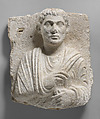Funerary relief
Not on view
Inscription:
(at right)
1 Mattanay, son of
2 Zubaida. Alas!
(On left, one or two illegible lines)
Transliteration:
1 mtny br
2 zby?dʾ ḥbl
This relief is a type of funerary monument characteristic of the prosperous caravan city of Palmyra during the first three centuries A.D. Reliefs with a representation of the deceased and a short identifying inscription were used to seal burial niches in elaborately decorated communal tombs; those with a half-length or bust format became prevalent sometime after A.D. 65.
Shown here is the upper body of a bearded man in high relief facing directly toward the viewer, dressed in a Greek cloak known as a himation, worn over a chiton, or tunic, and wrapped around the right arm like a sling. His left hand holds a looped fold of the himation. The background of the relief is blank except for an inscription in Palmyrene Aramaic to the right of his head giving his name and his father’s name, ending with an expression of sorrow common on funerary reliefs at Palmyra; one or two lines to the left of his head can no longer be deciphered. His upper eyelids are carefully outlined, with tear ducts indicated at the inner corners, and incised circles mark the iris of each eye. The arched eyebrows, marked by hatching, meet in the middle with two vertical furrows, creating a stern and distant expression. The gaze does not meet the viewer’s but extends far into the distance. The man’s short hair is depicted as a mass of wavy locks, slightly receding at the temples to suggest middle age, while his beard is made up of individual diamond-shaped tufts. Carved in soft local limestone, the relief shows signs of damage and wear, including flaking at the base and a break at the tip of the nose. It can be stylistically dated to around 200-273 A.D. because of the figure’s beard, the treatment of the eyes, and the manner in which he holds his himation in the left hand.
Due to rights restrictions, this image cannot be enlarged, viewed at full screen, or downloaded.

